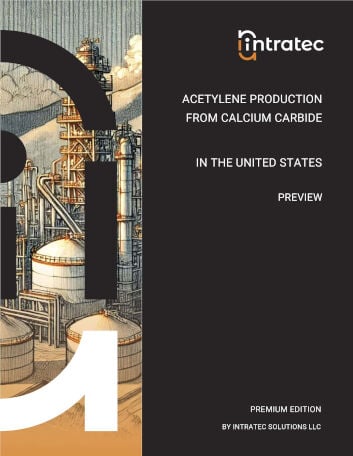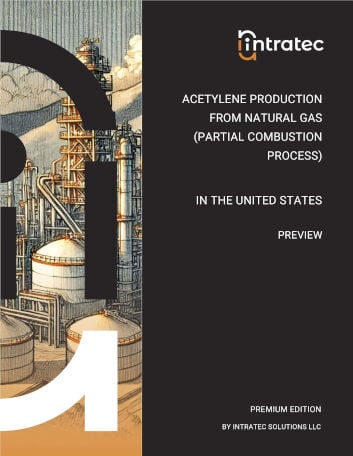Commodity Production Costs Report
Acrylic Acid Production from Acetylene
Acrylic Acid Plant Capital & Operating Cost Analysis | United States | Q3 2025
This report presents the economics of Ester-Grade Acrylic Acid (EAA) production from acetylene and carbon monoxide. The process sexamined is similar to the BASF process. In this process, acetylene is submitted to a catalytic carbonylation, producing Acrylic Acid.
The report provides a comprehensive study of Acrylic Acid production and related Acrylic Acid production cost, covering three key aspects: a complete description of the Acrylic Acid production process examined; an in-depth analysis of the related Acrylic Acid plant capital cost (Capex); and an evaluation of the respective Acrylic Acid plant operating costs (Opex).
The Acrylic Acid production process description includes a block flow diagram (BFD), an overview of the industrial site installations, detailing both the process unit and the necessary infrastructure, process consumption figures and comprehensive process flow diagrams (PFD). The Acrylic Acid plant capital cost analysis breaks down the Capex by plant cost (i.e., ISBL, OSBL and Contingency); owner's cost; working capital; and costs incurred during industrial plant commissioning and start-up. The Acrylic Acid plant operating costs analysis covers operating expenses, including variable costs like raw materials and utilities, and fixed costs such as maintenance, labor, and depreciation.

Product
Acrylic Acid. Acrylic acid, ester grade is a vital intermediate in the production of acrylate esters, which are widely used in adhesives, coatings, and textiles. Its reactivity enables it to form polymers that are valuable for water-based paints, adhesives, and textiles. Ester grade acrylic acid is typically produced through the oxidation of propylene. It is stored as a liquid and supplied to manufacturers who use it to create a range of acrylate-based products, driving demand across multiple industries.
Raw Materials
Acetylene. Acetylene (also known as ethyne) is the simplest alkyne and a very important commercial compound. It has several applications in the processing of metals, as well as in the manufacture of chemical compounds, such as vinyl chloride and 1,4-butanediol. This chemical is produced on commercial scale mainly from partial combustion of methane or as a side product in the ethylene stream from cracking of hydrocarbons.
Carbon Monoxide. Like hydrogen, carbon monoxide is produced industrially from syngas, but it is recovered via cryogenic distillation. Carbon monoxide is used in the chemical industries for the synthesis of several compounds, like acetic acid, polycarbonates, polyketones; and also in the metallurgical industry for the creation of reducing atmospheres.
Report in PDF Format
Download & Explore Anytime
Access in Various Devices
Print & Read Comfortably
Share With Co-workers
Up-to-date Report
Professional report based on Q3 2025 economic data, ensuring timely evaluations.
Multiple Use Cases
Ideal for investment screening, feasibility studies, cost estimates, and research planning.
Proven Methodology
Developed using a consistent methodology honed over a decade, ensuring reliable cost analyses.
Report Editions
Content Highlights
Plant Capital Cost Summary
Summary outlining the capital cost required for building the Acrylic Acid production plant examined.
Plant Capital Cost Details
Detailing of fixed capital (ISBL, OSBL & Owner’s Cost), working capital and additional capital requirements.
Plant Cost Breakdowns
Breakdown of Acrylic Acid process unit (ISBL) costs and infrastructure (OSBL) costs; plant cost breakdown per discipline.
Operating Costs Summary
Summary presenting the operating variable costs and the total operating cost of the Acrylic Acid production plant studied.
Operating Cost Details
Detailing of utilities costs, operating fixed costs and depreciation.
Plant Capacity Assessment
Comparative analysis of capital investment and operating costs for different Acrylic Acid plant capacities.
Production Process Information
Block Flow Diagram, descriptions of process unit (ISBL) and site infrastructure (OSBL).
Process Consumptions
Raw materials and utilities consumption figures, by-products credits, labor requirements
Process Diagrams
Process flow diagrams (PFD), equipment list and industrial site configuration
Other Acrylic Acid Production Cost Reports

Acrylic Acid Production from Glycerol
It presents the economics of Ester-Grade Acrylic Acid (EAA) production from crude glycerol in the USA using a two-step process similar to Arkema technology. In the process examined, crude glycerol, obtained from biodiesel plants, is dehydrated to acrolein, which is subsequently oxidized to Acrylic Acid.
Details: 100 kta United States-based plant | Q3 2025 | 107 pages | Issue B | From $799 USD

Bio-Acrylic Acid Production from Glucose (Single-Step Process)
This report shows a feasibility study of bio-based Acrylic Acid production from glucose syrup in a plant assumed to be located in the United States. The process is based on the fermentation route of glucose, yielding Acrylic Acid, similar to the speculative process proposed by the Delft University of Technology.
Details: 150 kta United States-based plant | Q3 2025 | 107 pages | Issue C | From $799 USD

Bio-Acrylic Acid Production from Raw Sugar (Single-Step Process)
This report shows a feasibility study of bio-based Acrylic Acid production from glucose syrup in a plant assumed to be located in Germany. The process is based on the fermentation route of raw sugar, yielding Acrylic Acid, similar to the speculative process proposed by the Delft University of Technology.
Details: 150 kta Germany-based plant | Q3 2025 | 107 pages | Issue D | From $799 USD
Bundle & Save
Purchase multiple Acrylic Acid Production Cost reports and enjoy tiered discounts
up to 30% off!
Could Not Find the Report You Need?
Obtain a Bespoke Report
Get a report targeting the process in which you are interested
See Offer Details
Understand Bespoke Reports and how you can easily order them
Check Editions & Pricing
Complete a brief form and see a quotation for your Bespoke Report
Other Related Production Cost Reports

Acetylene Production from Calcium Carbide
This study presents the economics of Acetylene production from calcium carbide in the United States via wet process. In the process, calcium carbide reacts with water to form Acetylene. Hydrated lime is generated as by-product.
Details: 200 kta United States-based plant | Q3 2025 | 107 pages | Issue D | From $799 USD

Glacial Acrylic Acid from Crude Acrylic Acid (Crystallization)
This report presents the costs associated with the construction of an industrial plant, in the United States, for crude acrylic acid purification to produce Glacial Acrylic Acid. The purification process examined is based on crude acrylic acid crystallization.
Details: 140 kta United States-based plant | Q3 2025 | 107 pages | Issue H | From $799 USD

Acetylene Production from Natural Gas (Partial Combustion Process)
This report presents the economics of Acetylene production from natural gas using a partial combustion process similar to that developed by BASF. In this process, methane from natural gas is cracked in high temperatures to acetylene and hydrogen. The economic analysis developed is based on a plant constructed in the United States.
Details: 50 kta United States-based plant | Q3 2025 | 107 pages | Issue A | From $799 USD

Butyl Acrylate Production from Acrylic Acid and Butanol
This report approaches the production of n-Butyl Acrylate from acrylic acid and n-butanol. The process examined is similar to the Synthomer's Butyl Acrylate Process. In this process acrylic acid and n-butanol are directly converted to Butyl Acrylate via an esterification reaction catalyzed by p-Toluene Sulfonic Acid. The economic analysis performed assumes a plant located in the United States.
Details: 150 kta United States-based plant | Q3 2025 | 107 pages | Issue A | From $799 USD
+800 Reports Developed, Targeting +250 Commodities
Vast Report Library
858 independent and up-to-date reports examining embryonic and established production processes.
Free Sample Reports
Quickly understand the structure and depth of content of our professional reports.

